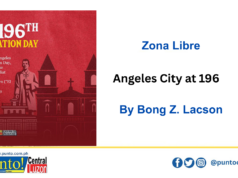CITY OF SAN FERNANDO — The Department of Environment and Natural Resources (DENR) here said yesterday that any effort to revive the Manila Bay will not succeed unless the 55-kilometer Marilao-Meycauayan-Obando (MMO) river in Bulacan is first rehabilitated and maintained.
The US-based Blacksmith Institute, an independent environmental group, in partnership with Green Cross Switzerland, classified the MMO river as among the world’s “30 dirtiest”.
Yet the river has continued to be a receptacle for at least 133,000 cubic meters of untreated wastewater and 400 tons of garbage each day, said DENR Regional Executive Director Antonio Principe.
Principe also noted that “government efforts to rehabilitate Manila Bay will be put to waste if water quality from the MMO river system does not improve because its waters eventually drain into the 1,800-square kilometer Manila Bay area”.
“Lead smelters, jewelry and gold refineries, tanneries, livestock raisers, and textiles and garments factories are among the top polluters of the river system,” he added.
Principe said “in seven towns and cities in Bulacan and Metro Manila alone, one million people dispose at least 400 tons of garbage into the river system daily, further contributing to its biochemical oxygen demand (BOD) loading of 57,000 kilograms a day.”
He explained that “BOD is the amount of dissolved oxygen consumed by microorganisms and aquatic life in a body of water. The higher the BOD level, the lower the available dissolved oxygen needed to support life.”
Principe appealed for “public vigilance and cooperation” in efforts to revive the river in Bulacan.
“What we need is to put our acts together to clean up our mess and stop the never-ending stream of trash that has choked the entire river system,” Principe stressed.
He noted that “past cleanup campaigns waged at the Prenza Dam in Marilao town did little to ease the garbage heap that accumulates there each day”.
He said the MMO river system falls under the political jurisdiction of the towns and cities of Marilao, Meycauayan, Obando, Sta Maria, and San Jose Del Monte in Bulacan, and Valenzuela and Caloocan in Metro Manila.
“What we need is for people from these towns and cities to stop polluting altogether and to collaborate in a massive and sustained rehabilitation of the river system, beginning with personal discipline and the strict enforcement of a ‘no dumping into the river’ policy,” he stressed.
“The MMO river system used to be an important source of food and livelihood for most Bulacan residents. In fact, the province is a major aquaculture center in the region,” he said, referring to the Bulacan’s still thriving fish and prawn industry.
Principe said “it is ironic that what serves as the backbone of the province’s multi-million fish and prawn industry could be subjected to so much pollution that one of its rivers has now become one of the world’s dirtiest.”
Principe also said some other river systems in Central Luzon are in similar condition, as he called on regional folk to help rehabilitate them “to stave off water shortage amid the worsening conditions of major water systems” in the region.
“Years of public indifference and indiscriminate dumping of garbage and untreated industrial wastes now threaten the supply of freshwater for irrigation and domestic use in Central Luzon,” he noted.
The DENR is set to initiate a massive cleanup drive of the 55-kilometer MMO river system on March 29 in a bid to save the river system from continuous degradation and in line with the annual observance of World Water Day and Philippine Water Week.
Environment Sec. Jose “Lito” Atienza will lead some 1,000 volunteers from local government units, non-government organizations, academe, environmental organizations, private and business sectors, and local communities in a massive cleanup campaign, said regional DENR chief of public affairs Perla Collado.
Atienza who was named “Champion of Philippine Waters” by Mother Earth Institute last year, has been pushing for the rehabilitation of Manila Bay.
The International World Water Day was first celebrated in 1993 as a result of the United Nations effort to shift world attention on the need for sustainable management of freshwater resources.
Collado said this year’s international theme “Shared Water, Shared Opportunities” aims to focus world attention on the trans-boundary issues of freshwaters, with the local theme “Makibahagi at Pagyamanin, Tubig Natin” highlighting the significance of cooperation of water agencies, stakeholders and local governments to promote clean and healthy rivers.
She noted that in Central Luzon alone, each of the nine million people needs about 400 liters of freshwater a day for drinking, cooking, and washing.
Pantabangan and Angat Dams in Nueva Ecija and Bulacan are the only major sources of freshwater for domestic use, irrigation, and hydroelectric power generation in Central Luzon, both of which are threatened by siltation caused by degradation of surrounding watersheds, she noted.
The US-based Blacksmith Institute, an independent environmental group, in partnership with Green Cross Switzerland, classified the MMO river as among the world’s “30 dirtiest”.
Yet the river has continued to be a receptacle for at least 133,000 cubic meters of untreated wastewater and 400 tons of garbage each day, said DENR Regional Executive Director Antonio Principe.
Principe also noted that “government efforts to rehabilitate Manila Bay will be put to waste if water quality from the MMO river system does not improve because its waters eventually drain into the 1,800-square kilometer Manila Bay area”.
“Lead smelters, jewelry and gold refineries, tanneries, livestock raisers, and textiles and garments factories are among the top polluters of the river system,” he added.
Principe said “in seven towns and cities in Bulacan and Metro Manila alone, one million people dispose at least 400 tons of garbage into the river system daily, further contributing to its biochemical oxygen demand (BOD) loading of 57,000 kilograms a day.”
He explained that “BOD is the amount of dissolved oxygen consumed by microorganisms and aquatic life in a body of water. The higher the BOD level, the lower the available dissolved oxygen needed to support life.”
Principe appealed for “public vigilance and cooperation” in efforts to revive the river in Bulacan.
“What we need is to put our acts together to clean up our mess and stop the never-ending stream of trash that has choked the entire river system,” Principe stressed.
He noted that “past cleanup campaigns waged at the Prenza Dam in Marilao town did little to ease the garbage heap that accumulates there each day”.
He said the MMO river system falls under the political jurisdiction of the towns and cities of Marilao, Meycauayan, Obando, Sta Maria, and San Jose Del Monte in Bulacan, and Valenzuela and Caloocan in Metro Manila.
“What we need is for people from these towns and cities to stop polluting altogether and to collaborate in a massive and sustained rehabilitation of the river system, beginning with personal discipline and the strict enforcement of a ‘no dumping into the river’ policy,” he stressed.
“The MMO river system used to be an important source of food and livelihood for most Bulacan residents. In fact, the province is a major aquaculture center in the region,” he said, referring to the Bulacan’s still thriving fish and prawn industry.
Principe said “it is ironic that what serves as the backbone of the province’s multi-million fish and prawn industry could be subjected to so much pollution that one of its rivers has now become one of the world’s dirtiest.”
Principe also said some other river systems in Central Luzon are in similar condition, as he called on regional folk to help rehabilitate them “to stave off water shortage amid the worsening conditions of major water systems” in the region.
“Years of public indifference and indiscriminate dumping of garbage and untreated industrial wastes now threaten the supply of freshwater for irrigation and domestic use in Central Luzon,” he noted.
The DENR is set to initiate a massive cleanup drive of the 55-kilometer MMO river system on March 29 in a bid to save the river system from continuous degradation and in line with the annual observance of World Water Day and Philippine Water Week.
Environment Sec. Jose “Lito” Atienza will lead some 1,000 volunteers from local government units, non-government organizations, academe, environmental organizations, private and business sectors, and local communities in a massive cleanup campaign, said regional DENR chief of public affairs Perla Collado.
Atienza who was named “Champion of Philippine Waters” by Mother Earth Institute last year, has been pushing for the rehabilitation of Manila Bay.
The International World Water Day was first celebrated in 1993 as a result of the United Nations effort to shift world attention on the need for sustainable management of freshwater resources.
Collado said this year’s international theme “Shared Water, Shared Opportunities” aims to focus world attention on the trans-boundary issues of freshwaters, with the local theme “Makibahagi at Pagyamanin, Tubig Natin” highlighting the significance of cooperation of water agencies, stakeholders and local governments to promote clean and healthy rivers.
She noted that in Central Luzon alone, each of the nine million people needs about 400 liters of freshwater a day for drinking, cooking, and washing.
Pantabangan and Angat Dams in Nueva Ecija and Bulacan are the only major sources of freshwater for domestic use, irrigation, and hydroelectric power generation in Central Luzon, both of which are threatened by siltation caused by degradation of surrounding watersheds, she noted.




